
 |
Home | Gasherbrum II References | Contact |
Photo Galleries

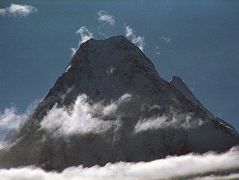
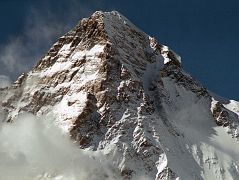
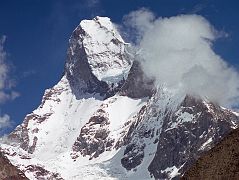
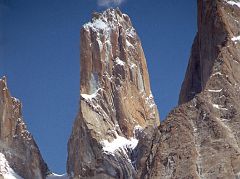


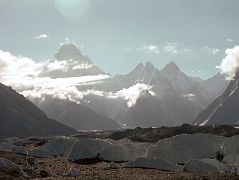
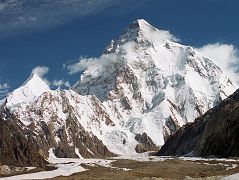
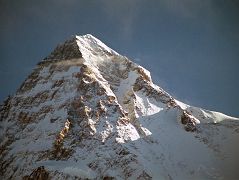
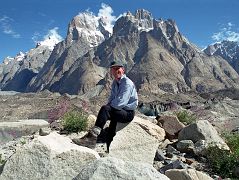
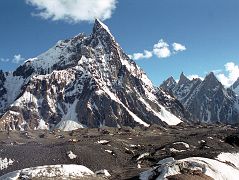
Gasherbrum North Photo Galleries
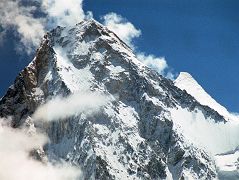


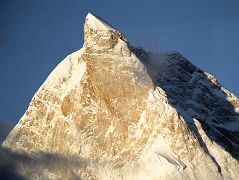
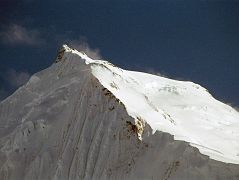

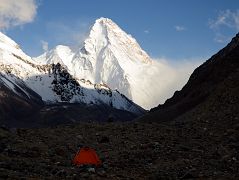
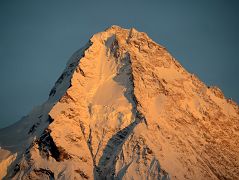




Gasherbrums North Face Youtube Videos












Updated: September 2014. Click on an image to see the FULL size with a caption.
To see the full list of photos, see K2 Photo Gallery.
Gasherbrum is a remote group of peaks located at the north-eastern end of the Baltoro Glacier in the Karakoram range of the Himalaya. The massif contains two of the world's 8000m peaks. In 1856, Thomas George Montgomerie, a British Royal Engineers lieutenant and a member of the Great Trigonometric Survey of India, sighted a group of high peaks in the Karakoram from more than 200 km away. He named five of these peaks K1, K2, K3, K4 and K5 where the K denotes Karakoram. Today, K1 is known as Masherbrum, K3 as Broad Peak, K4 as Gasherbrum II and K5 as Gasherbrum I. Only K2, the second highest mountain in the world, has kept Montgomerie's name.
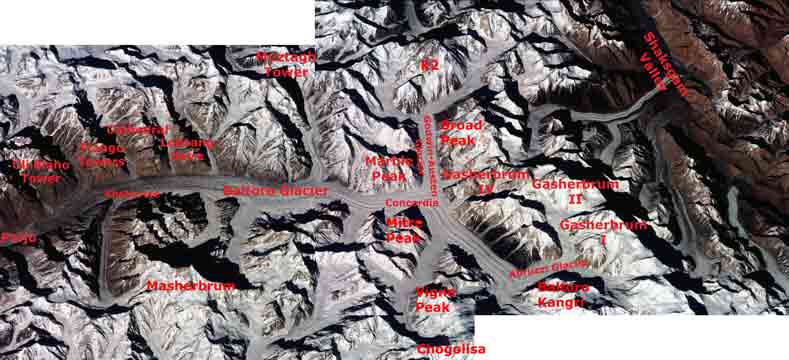
After flying from Islamabad to Skardu with an amazing view of Nanga Parbat, driving from Skardu to Thongol, and trekking from Thongol to Paiju, I set foot on the Baltoro Glacier. I trekked to Khoburtse that first day with a stunning view of Trango Nameless Tower and the Great Trango Tower. I had a dazzling sunrise from Khoburtse with views of Paiju Peak, Uli Biaho Tower, Trango Towers, Cathedral, and Lobsang Spire. The next trekking day we went from Khoburtse to Goro II where Masherbrum was striking both at sunset and sunrise while Gasherbrum IV loomed ahead with Gasherbrum II poking out to its right.
The next day was a fairly short trekking day passing Muztagh Tower before arriving at Concordia, the highlight of the whole trek with K2 dominating the view at the head of the Godwin-Austen Glacier. Rotating in a circle at Concordia, the view has K2, Broad Peak, Gasherbrum IV, Baltoro Kangri, Vigne Peak, Mitre Peak, Paiju Peak, the spires of the Baltoro Glacier, Crystal Peak and Marble Peak. WOW! Spectacular! Breathtaking!
The next day we trekked on the Upper Baltoro Glacier to Shaqring Camp with views of Chogolisa and Baltoro Kangri. Cloudy weather rolled in as we trekked on the Abruzzi Glacier to Gasherbrum Base Camp with a brief view of Gasherbrum I. After back-tracking to Concordia it snowed, so we decided to return back down the Baltoro Glacier instead of waiting for the weather to clear and the snow to melt.
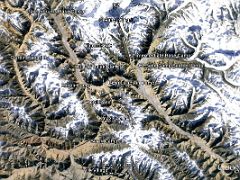
After flying from Beijing to Urumqi and Kashgar, we drove to Karghilik and finally to Yilik village (3504m). The trek was easy to Sarak Camp (3759m) and Kotaz Camp (4330m) before crossing the Aghil Pass (4810m) and descending to the Shaksgam Valley (4000m). The trail was along the wide expanse of the Shaksgam River to a beautiful camp at Kerqin (3968m) with small flowers and mountain views. The trail to K2 Base Camp continues on the flat Shaksgam Valley to River Junction Camp (3824m) and then to the Sarpo Laggo Valley and Sughet Jangal (3900m). The trek was fairly short to K2 Intermediate Base Camp (4462m) with spectacular views of K2 North Face, especially at sunset. I was the only person at this lonely camp.
I retraced the trail back to River Junction and Kerqin camps, passed the valley from Aghil Pass and continued to Kulqin Bulak Camp (4060m) and Gasherbrum North Base camp (4294m) with breathtaking views of Gasherbrum I, Gasherbrum II and Gasherbrum III. We then retraced to Yilik Village and back to Kasgkar and Beijing.
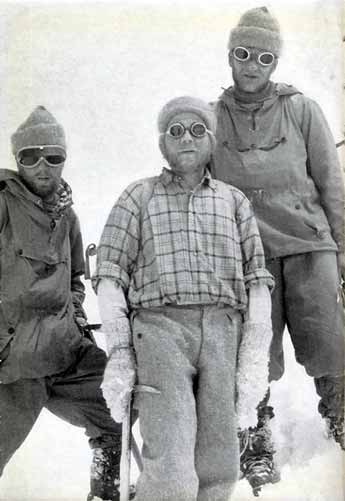
Fritz Moravec led an expedition of 5 climbers, a geologist and doctor to Gasherbrum II in 1956. After setting up Camp I (6000m) they had to descend in bad weather. This was lucky because when they went back up on June 30, they found Camp I completely buried under a huge avalanche. They had lost most of their food and nearly all the high-altitude equipment. Rather than descend they decided on a fast, lightly mounted attempt on the summit. In just four days they opened up a new route over very steep snow and ice slopes as far as 7000m. They then decided to make a rapid bid for the summit with a bivouac halfway.
Moravec, Larch and Willenpart left Camp III in the afternoon of July 6, climbing unroped in bad snow, bivouacking at 7500m. They started at dawn the next day in fine weather and plodded painfully on, metre by metre in deep snow. Fritz Moravec, Sepp Larch and Hans Willenpart completed the first ascent of Gasherbrum II summit on July 7, 1956 at 13:30. "On the summit, the wind was still, and we enjoyed the unforgettable wonderful view. ... The ascent of Gasherbrum II was not a victory over the mountain. The mountain was kind to us. The weather and the circumstances were good."
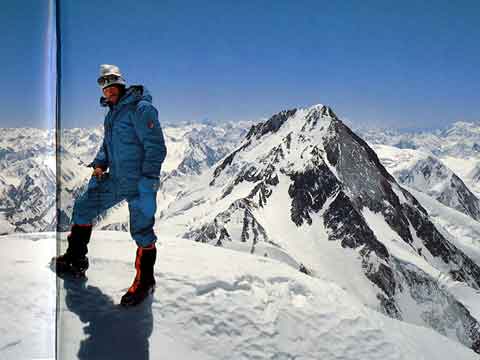
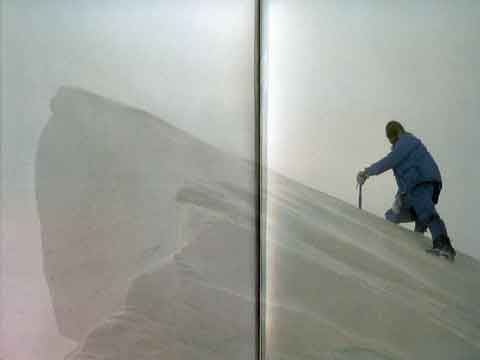
From June 23 to 30, 1984, Reinhold Messner and Hans Kammerlander traversed Gasherbrum II and Gasherbrum I in Alpine Style, reaching the summit of Gasherbrum II on June 25, descending to a pass, and reaching the summit of Gasherbrum I on June 28.
'In three days in radiant weather we were on the summit of Gasherbrum II. ... The next morning we risked the dangerous descent into the Gasherbrum Valley ... Only if we forced ourselves – exhausted, emaciated and without back-up – to venture the second peak, could we succeed in what no one had previously attempted – the combined traverse of two of the highest mountains in the world without rest and without outside help. ... Suddenly it became uncannily gloomy. The storm increased to hurricane force ... Our goggles were iced up, our faces numb. ... At last, behind a cornice was the summit! The second eight-thousander within four days.' - To The Top Of The World by Reinhold Messner.
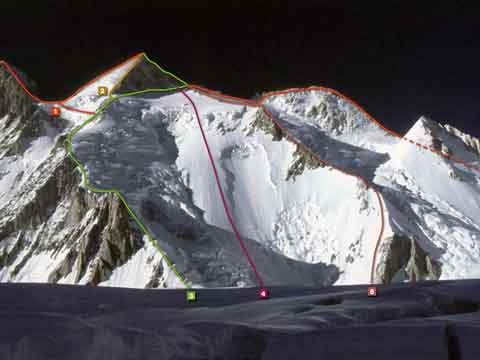
The first ascent of Gasherbrum II via the East Ridge was completed by Jerzy Kukuczka and Wojciech Kurtyka on July 1, 1983. Wojciech Voytek Kurtyka in American Alpine Journal: Our first acclimatization trip took us through the Gasherbrum icefall and the southern cwm to the Gasherbrum La (6500m) and up the southeast ridge to the distinctive snow pyramid of 7200m, where we bivouacked for the third night of that trip. On the second acclimatization trip we regained the pyramid and continued along the southeast ridge to the prominent unclimbed P7772, clearly visible from Base Camp to the right of Gasherbrum II. The night spent on the summit gave us good acclimatization before the final assault.
This assault, though on partly reconnoitered terrain, was alpine style. On June 29 we climbed in a long day from Base Camp to the Gasherbrum La. The next day we climbed to 24,275 feet. On the last and summit day, July 1, we traversed over P7772 and after climbing the connecting ridge, we reached the base of the summit cone of Gasherbrum II at 25,250 feet, the junction point with the original (normal) route. Here we left our rucksacks. At four P.M. in increasing wind we got to the short summit ridge and traversed onto the western side. The wind changed to a hurricane. We fought the last meters through violent gusts to the summit (8035m). The next morning we started down the original route, totally unknown to us. In a stormy blizzard we luckily found our way and after ten hours' descent we reached Base Camp.

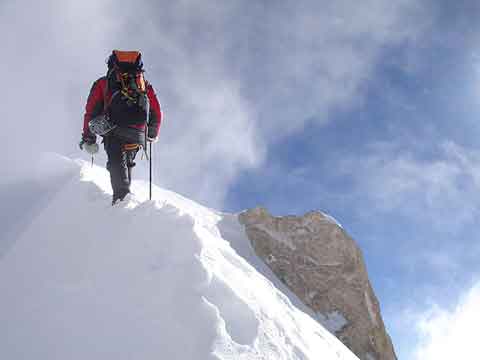
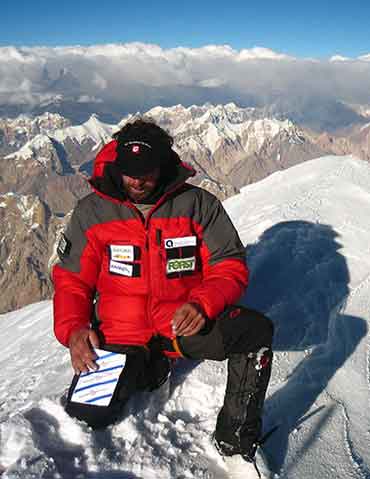
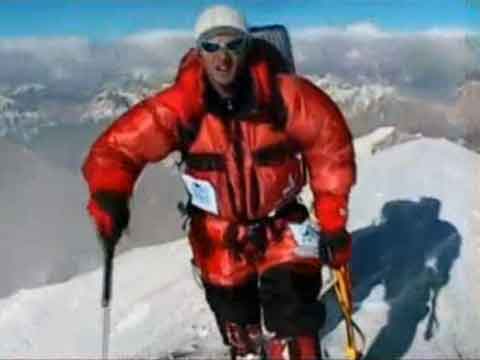
Karl Unterkircher on Karlunterkircher.com: In July 2007, I, Karl Unterkircher, together with my comrades Michele Compagnoni and Daniele Bernasconi set off for this expedition so much desired, the Gasherbrum 2. ... After setting up Base Camp at 4800 meters we set about a first attempt at climbing the rock pillar. ... We decided the best way to continue would be in alpine style carrying all necessary things with us in our backpacks to the peak. From base camp we then did several ascents on lower peaks to favour our acclimatization.
On [July] 18th the weather looks good and we're off! We re-climbed the lines that we previously fixed on the pillar until we reached our tent on the plateau. The next day at 4 am we set off to challenge this most difficult and dangerous wall. We started with great difficulty beating a track, often sinking until our thighs into the fresh snow which had fallen over the last few days. We attack the wall to the left of the edge where the slope is more gradual, continuing with the gradient getting steadily greater and greater (approx: 55°). We make it to about 7000 meters where we stop at an interruption in the line of snow which drops vertically from the wall. We had to dig to create a small space for our tent on this immense and exposed wall.
On the 20th [we leave] at 9 am as first sun ray breaks through the clouds. From here the climb gets steeper still and we continue slowly to the altitude of 7600 meters where we get to a huge belt which separates G2 from G3. From here it is clear that we are over the most difficult part of the Gasherbrum 2. After 11 hours of continuous climb we finally make it to the peak. YES !!! It’s 20.00 Chinese time and 17.00 Pakistani time. Karl Unterkircher and Daniele Bernasconi completed the first ascent of Gasherbrum North Face on July 20, 2007. Compagnoni (the nephew of Achille Compagnoni) traversed off to the Normal Route at 7850m. The three climbers then descended the normal route to Gasherbrum Base Camp in Pakistan.

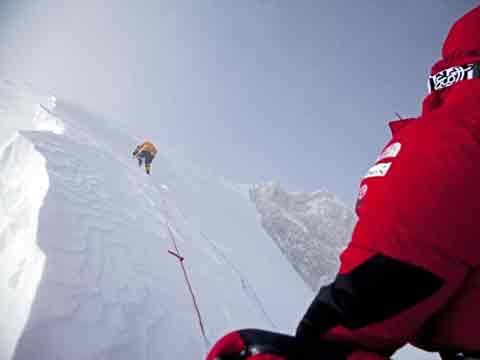

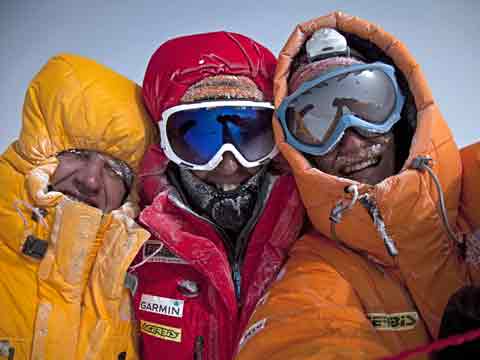
Simone Moro, Cory Richards, and Denis Urubko completed the first winter ascent of Gasherbrum II on February 2, 2011. This is the first of the five 8000m peaks in Pakistan to have a successful winter ascent. The fast summit came just 22 days after reaching Base Camp with an extremely lightweight expedition.
Using a military helicopter they ride from Paiju to Gasherbrum Base Camp passing Trango Towers, K2 and Broad Peak. After setting up base camp, they climb up the Gasherbum Glacier with Gasherbrum II above. After only a brief rest at Base Camp, they decided to go for the summit when a 36-hour good weather window was forecasted in the next few days. They left base camp in a storm and climbed over consecutive days to Camp I (5900m), Camp II (6500m) and Camp III (6900m) when the weather improved. They left Camp III on February 2, 2001 at 3am. The sun greeted them as they reached 7600m, and they climbed on with Denis leading the last section to the summit. Cory: 'And suddenly as if in a dream we were there on top of Gasherbrum II in the heart of Winter.' Denis Urubko, Simone Moro, and Cory Richards completed the first Winter Ascent of any Pakistani 8000m peak on February 2, 2011 when they reached the summit of Gasherbrum II.
They made it back to Camp III that night in worsening weather and only to Camp I the next day. Cory: 'The following morning after our fifth night in freezing sleeping bags we began the descent to base camp in terrible weather, the worst we'd seen yet. ... As a massive avalanche off the slopes of G5 overtook us the world became chaotic and black.' All three of them were carried down about 150m and luckily all ended up mostly on top. Cory was mostly buried, but his face was out. Denis was mostly buried, but his face was out. Simone was able to get out of the snow and dig Cory and Denis out. Six hours later they made it back to Gasherbrum Base Camp.